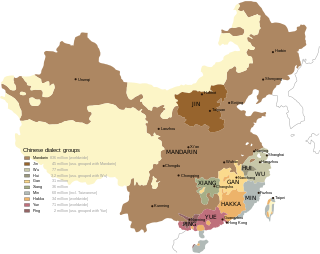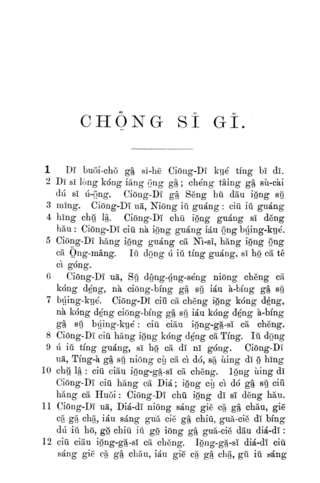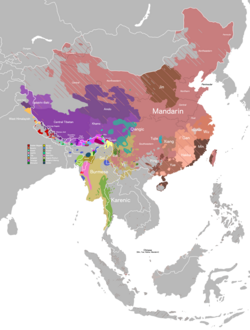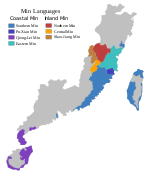
Hainanese, also known as Qiongwen or Qiongyu, is a group of Min Chinese varieties spoken in the southern Chinese island province of Hainan and Overseas Chinese such as Malaysia. In the classification of Yuan Jiahua, it was included in the Southern Min group, being mutually unintelligible with other Southern Min varieties such as Hokkien–Taiwanese and Teochew. In the classification of Li Rong, used by the Language Atlas of China, it was treated as a separate Min subgroup. Hou Jingyi combined it with Leizhou Min, spoken on the neighboring mainland Leizhou Peninsula, in a Qiong–Lei group. "Hainanese" is also used for the language of the Li people living in Hainan, but generally refers to Min varieties spoken in Hainan.

The Fuzhou dialect, also Foochow, Hokchew, Hok-chiu, or Fuzhounese, is the prestige variety of the Eastern Min branch of Min Chinese spoken mainly in the Mindong region of Eastern Fujian Province. As it is mutually unintelligible to neighbouring varieties in the province, under a technical linguistic definition Fuzhou is a language and not a dialect. Thus, while Fuzhou may be commonly referred to as a 'dialect' by laypersons, this is colloquial usage and not recognised in academic linguistics. Like many other varieties of Chinese, the Fuzhou dialect is dominated by monosyllabic morphemes that carry lexical tones, and has a mainly analytic syntax. While the Eastern Min branch it belongs to is relatively closer to other branches of Min such as Southern Min or Pu-Xian Min than to other Sinitic branches such as Mandarin, Wu Chinese or Hakka, they are still not mutually intelligible.

The Sinitic languages, often synonymous with the Chinese languages, are a group of East Asian analytic languages that constitute a major branch of the Sino-Tibetan language family. It is frequently proposed that there is a primary split between the Sinitic languages and the rest of the family. This view is rejected by a number of researchers but has found phylogenetic support among others. The Greater Bai languages, whose classification is difficult, may be an offshoot of Old Chinese and thus Sinitic; otherwise Sinitic is defined only by the many varieties of Chinese unified by a shared historical background, and usage of the term "Sinitic" may reflect the linguistic view that Chinese constitutes a family of distinct languages, rather than variants of a single language.
The Danzhou dialect, locally known as Xianghua, is a Chinese variety of uncertain affiliation spoken in the area of Danzhou in northwestern Hainan, China. It was classified as Yue in the Language Atlas of China, but in more recent work is treated as an unclassified southern variety.
The Changsha dialect is a dialect of New Xiang Chinese. It is spoken predominantly in Changsha, the capital of Hunan province, China. It is not mutually intelligible with Standard Mandarin, the official language of China.
The Shuangfeng dialect is a dialect of Xiang Chinese, spoken in Shuangfeng County, Hunan province, China.
Chang–Du or Chang–Jing, sometimes called Nanchang after its principal dialect, is one of the Gan Chinese languages. It is named after Nanchang and Duchang County, and is spoken in those areas as well as in Xinjian, Anyi, Yongxiu, De'an, Xingzi, Hukou, and bordering regions in Jiangxi and in Pingjiang County, Hunan.
The Jinan dialect is a Mandarin Chinese dialect spoken in Jinan in Shandong province, China. It is a variety of Jilu Mandarin.

The Jian'ou dialect, also known as Kienow dialect, is a local dialect of Northern Min Chinese spoken in Jian'ou in northern Fujian province. It is regarded as the standard common language in Jian'ou.
Ang Ui-jin is a Taiwanese linguist. He was the chief architect of the Taiwanese Language Phonetic Alphabet and remains a scholar in the progressive reform and development of Taiwanese Hokkien.
The Fuqing dialect, or Hokchia, is an Eastern Min dialect. It is spoken in the county-level city of Fuqing, China, situated within the prefecture-level city of Fuzhou. It is not completely mutually intelligible with the Fuzhou dialect.
Differing literary and colloquial readings for certain Chinese characters are a common feature of many Chinese varieties, and the reading distinctions for these linguistic doublets often typify a dialect group. Literary readings are usually used in loanwords, names, literary works, and in formal settings, while colloquial/vernacular readings are usually used in everyday vernacular speech.
William Hubbard Baxter III is an American linguist specializing in the history of the Chinese language and best known for his work on the reconstruction on Old Chinese.

Jerry Lee Norman was an American sinologist and linguist known for his studies of Chinese dialects and historical phonology, particularly on the Min Chinese dialects, and also of the Manchu language. Norman had a large impact on Chinese linguistics, and was largely responsible for the identification of the importance of the Min Chinese dialects in linguistic research into Old Chinese.
Ken-ichi Takashima is, according to the editors of the Thesaurus Linguae Sinicae, "the world's leading authority on Shang dynasty oracle bone inscriptions".
Yu Min was an influential Chinese linguist, a 1940 graduate of the Fu Jen Catholic University, Chinese Department, a former professor of Yenching University, and professor of Beijing Normal University. His primary research areas were Chinese historical linguistics, Sino-Tibetan comparison, the study of Sanskrit in Chinese transcription. His collected writings were published posthumously in 1999.

The Leizhou stone dogs are historical canine sculptures from the Leizhou Peninsula. They blend the locally-held tradition of totem worship with different ethnic cultures. In the past, the Leizhou Peninsula was an inhospitable land with relatively few inhabitants. Due the difficulty of bearing and raising children while living in such harsh conditions, the original inhabitants worshipped dogs, which could easily give birth to their offspring. Numerous stone dogs are widely distributed at village entrances, roads, and gates. The Stone Dogs are an important part of the local cultural history, and have many meanings and shapes. They are roughly carved, and have turned grayish from long term exposure to the elements. They are considered a highlight of the peninsula's culture.
Jizhao is an unclassified Kra-Dai language spoken in Jizhao Village 吉兆村, Tanba Town 覃巴镇, Wuchuan, Guangdong. It may be most closely related to Be. In Wuchuan, Jizhao is locally referred to as Haihua 海话, which is the term used elsewhere in Leizhou 雷州, Xuwen 徐闻, and Maoming 茂名 to refer to the local Minnan Chinese dialect of Leizhou.
Shehua is an unclassified Sinitic language spoken by the She people of Southeastern China. It is also called Shanha, San-hak (山哈) or Shanhahua (山哈话). Shehua speakers are located mainly in Fujian and Zhejiang provinces of Southeastern China, with smaller numbers of speakers in a few locations of Jiangxi, Guangdong and Anhui provinces.

Chaoshan or Teo-Swa is a Southern Min language spoken by the Chaoshan people of the Chaoshan region of eastern Guangdong province, China, and by their diaspora around the world. It is closely related to Hokkien, with which it shares some cognates and phonology, and the two are mutually intelligible.









